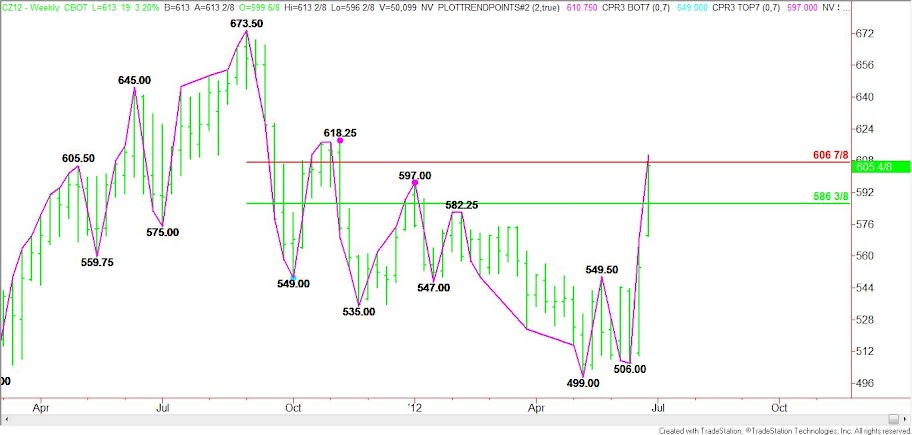Hot, dry weather in key growing areas in the Midwest has triggered a price surge in Soybeans, Corn and Wheat futures over the past two weeks, threatening the size of the crop in agricultural markets already facing tight supply situations.
After reaching a bottom at $4.99 per bushel in mid-May, December Corn lingered inside of a 50 cent range, even threatening to make a new low for the growing season following a trade to $5.06 on June 15. However, the forecast for severe growing conditions helped trigger a short-covering rally that has sent Corn prices soaring to price levels not seen since October 2011. Over less than a two-week period, December Corn has regained over 62% of its previous loss. If the hot and dry conditions persist, corn could continue to rally until at least July 6 when seasonal selling pressure could help put in a top.
There is an old adage that corn should be “knee high by the 4th of July”. This saying is usually attributed to the fact that during a normal growing season, corn will be going through a phase in the growing process that calls for tremendous demand for water. During the first week of July, traders usually decide the size of the crop and whether it will be sufficient enough to cover demand.
Corn Future Prices

Last week the U.S. Agriculture Department said that about 63% of the corn crop was in good-to-excellent condition, compared with 66% the previous week. With the return of triple-digit temperatures this week, the amount of good-to-excellent crop is likely to fall even further.
Recommended
If the plant receives the water it needs to pollinate then it is likely to develop normally. If the plant does not receive sufficient moisture during the pollination process then damage could occur. Needless to say, corn is going through this important process now, leading speculators to believe the size of the crop will not turn out as large as originally expected. This is the reason behind the current rally.
Corn prices like the weather can turn fast so timely rains could help put in a top over the next two weeks. Although there is tremendous upside potential during a bull market, there is also the danger that a sudden shift in the weather could lead to profit-taking and the start of a sharp sell-off. The decision by traders to chase this market higher carries the risk that timely rains will put an end to the move and trigger a rapid sell-off.
Soybean futures are also rallying sharply higher. The concern with this market is that unusually tight supplies will shrink further keeping nearby cash market prices at a premium. While corn is going through its critical phase in the growing process at this time, Soybeans will need rain during the first two-weeks of August. With over a month to go until this time period, the soybean crop is facing tremendous growing risks.
Wheat futures are also soaring although this rapid up move is being attributed to greater demand since it can be used as a feed substitute for corn. Greater than expected demand for wheat could mean that this crop will also face an unexpected supply drawdown that could lead to tight conditions the rest of the year.
While bullish speculators are celebrating the return of the bull market to U.S. agricultural markets, consumers will likely feel this surge later in the year in the form of higher food prices, particularly meat and cereal. Timely rains over the next two weeks could save the crop, but the damage may already be done.

























Join the conversation as a VIP Member